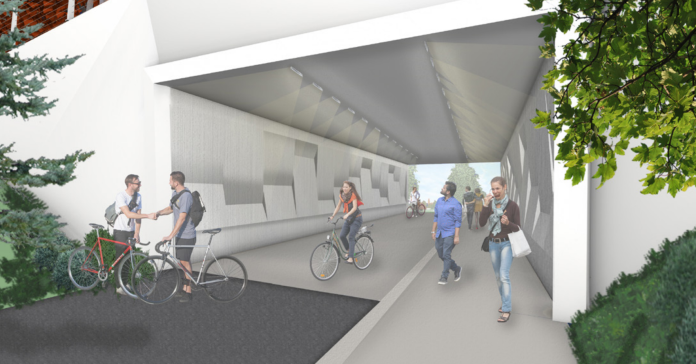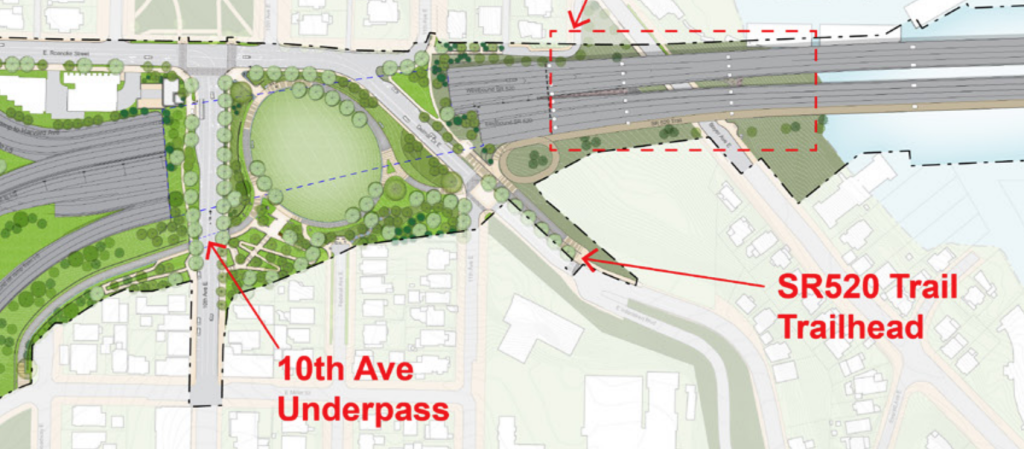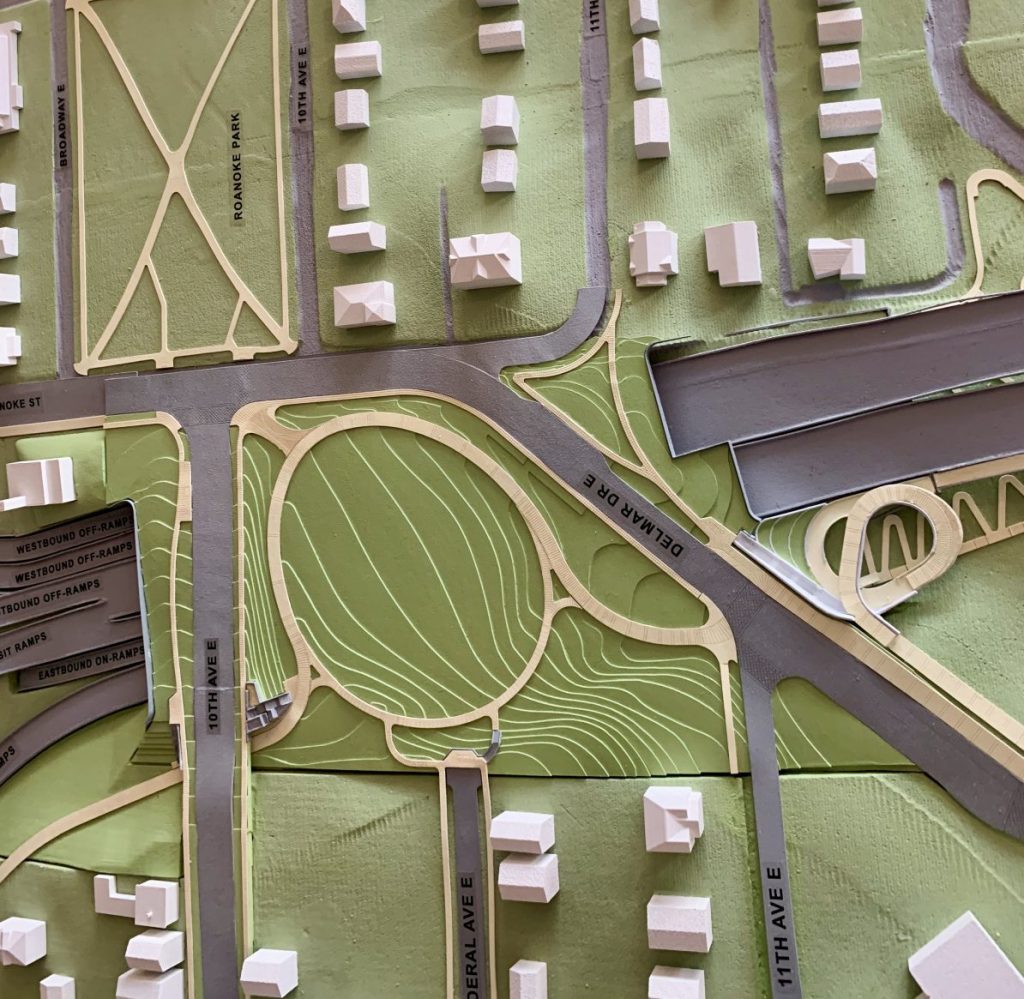
The Washington State Department of Transportation (WSDOT) is no longer moving forward with the removal of a bike and pedestrian tunnel from plans for a highway lid over State Route 520 in Seattle’s North Capitol Hill, the department announced this week. The tunnel had been planned for a full decade as the Roanoke Lid advanced toward construction, but its elimination had been explored by WSDOT after a direction to find scope changes that could reduce costs in the face of anticipated budget shortfalls impacting the entire state transportation budget in future years.
However, advocacy from Seattle residents concerned about losing the connection prompted a reversal. That pressure was focused both on WSDOT and on the state lawmakers who represent the 43rd Legislative District where the project is located. One online petition sponsored by Seattle Neighborhood Greenways and boosted by The Urbanist garnered more than 9,000 signatures.
The plan to no longer build the trail tunnel was first covered by The Urbanist back in May, following a fight earlier this year at the legislature to allocate the funding necessary to build the last major project included in the full replacement of the 520 floating bridge. Eliminating the tunnel was only expected to yield a cost savings of $10 to $15 million, on a project with a total budget of $1.375 billion, which includes both the lid and the replacement of two highway bridge spans across Portage Bay.
While the savings were small, WSDOT tried to minimize the impact of removing the trail connection, which will allow people who walk and bike to connect underneath 10th Avenue E, avoiding a traffic-clogged trouble spot, to directly access the new highway lid and extension of the 520 Trail to Montlake and the Eastside that the project is planned to bring.

“We identified the Harvard Connection as a potential cost reduction measure because there are alternative walking/biking connections in the area that provide a similar function. We saw this as an opportunity to align resources with the city of Seattle to improve the alternative connections, reduce maintenance costs and concerns, and preserve approximately 50 mature trees,” 520 program administrator Omar Jepperson wrote in making the announcement. “However, following conversations with legislators, our contractor, project partners and community advocates, we have decided to maintain the Harvard Connection. It is clear the community feels strongly about keeping this bicycle and pedestrian connection. We look forward to delivering these multimodal improvements to the city and region.”
Despite the fact that WSDOT touted some initial buy-in from Seattle’s multimodal advocacy organizations, local groups like Central Seattle Greenways (CSG), after making field visits to the streets where users would be directed without the tunnel, strenuously pushed back on the idea that deleting the connection would have minimal impact.
“WSDOT has justified their shortsighted decision by asserting that the path wouldn’t provide a meaningful connection. This is not accurate: it would provide a valuable alternative for southbound trips from the Roanoke Lid with gentler (6%) grades and lower traffic stress than navigating the busy intersection of 10th Ave E and E Roanoke St and the block south of it, which has a 10% slope,” a recent action alert from CSG noted.
In an op-ed in The Urbanist, CSG member Sam Luikens argued that Seattle as a whole would be worse off down the road without the Harvard connection. “Seattle is reckoning with its growth. State legislatures and planning departments should be prioritizing opportunities that connect communities with their sense of place in a way that doesn’t actively harm us,” Luikens wrote. “WSDOT should keep its agreement that the Harvard Connection be built as planned.”
The apparent process for cutting the tunnel also raised eyebrows. The elements of what a Roanoke Lid in North Capitol Hill would include were the result of months of neighborhood engagement back in 2019, in a process that involved Seattle’s Design Commission. But in May, when WSDOT announced that the tunnel was being dropped from the project, the decision was framed as final, with a need to move fast so that Skanska, the selected contractor on the project, could get started with final design work.

The fact that one of the few highway project elements being considered for a cut was one that would be used exclusively by people who will walk or bike did strike many multimodal advocates as being fairly upside-down, given adopted state and local goals around mode shift and climate action. Long considered nice-to-have add-ons, multimodal improvements like shared-use trails and highway lids are being increasingly seen as essential elements of urban highway projects. While not directly covered under WSDOT’s new Complete Streets mandate, the Harvard Avenue tunnel does represent that shift, and its deletion would have been a big step backward.
The involvement of 43rd District legislators Nicole Macri and Jamie Pedersen appears to have been crucial to getting WSDOT to back off the plan to remove the trail tunnel. In mid-July, the two state lawmakers held a meeting with WSDOT staff where they recommended that it be preserved, and afterward, Senator Pedersen wrote to a constituent that he was “reasonably confident that we will succeed in changing their course.”
This isn’t the first time that the 43rd’s legislative delegation has jumped into the fray when it comes to the 520 project. Last fall, following the installation of a large sign bridge over Montlake Place E just south of the planned highway lid in Montlake, WSDOT held community forums to field community concerns that the signs were too large, both Pedersen and Macri played a central role. In the end, nearby residents were successful in advancing an alternative sign plan that includes both smaller hardware and smaller highway road signs.
This week’s decision to retain the tunnel is a big win for local advocacy and a good reminder that just because decisions appear final doesn’t mean they actually are.
Ryan Packer has been writing for The Urbanist since 2015, and currently reports full-time as Contributing Editor. Their beats are transportation, land use, public space, traffic safety, and obscure community meetings. Packer has also reported for other regional outlets including BikePortland, Seattle Met, and PubliCola. They live in the Capitol Hill neighborhood of Seattle.

